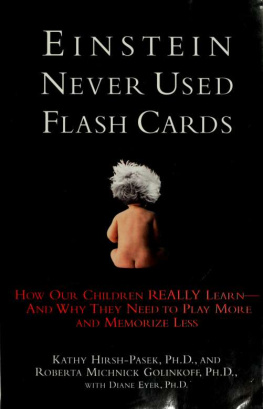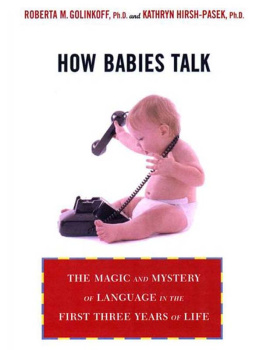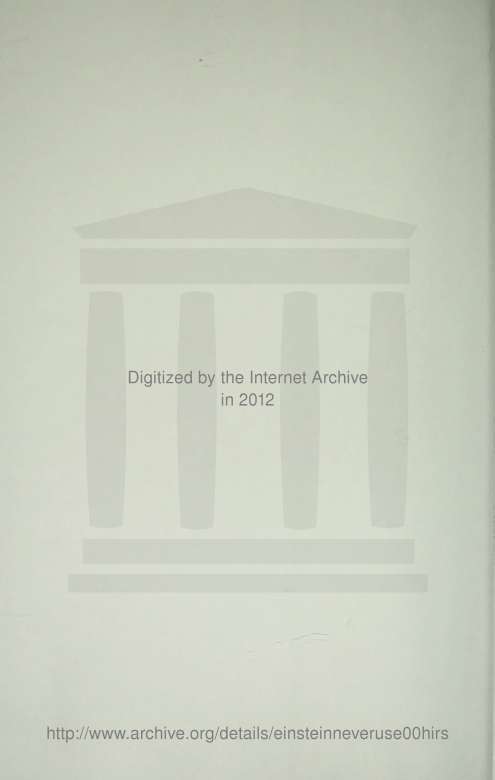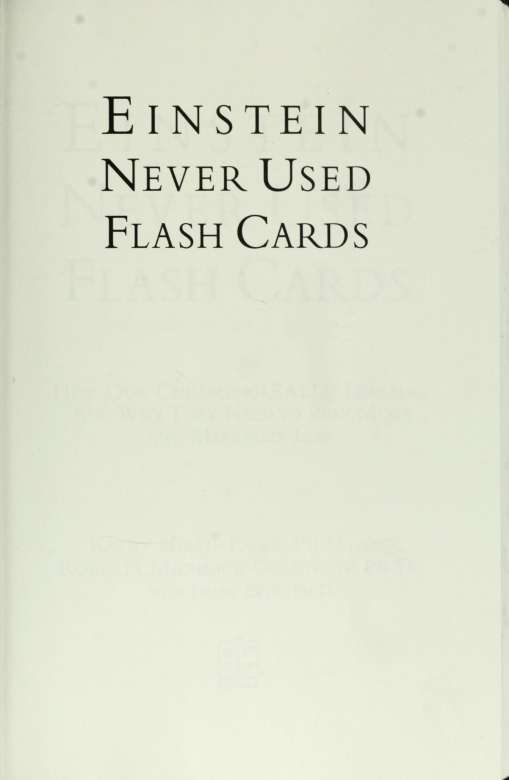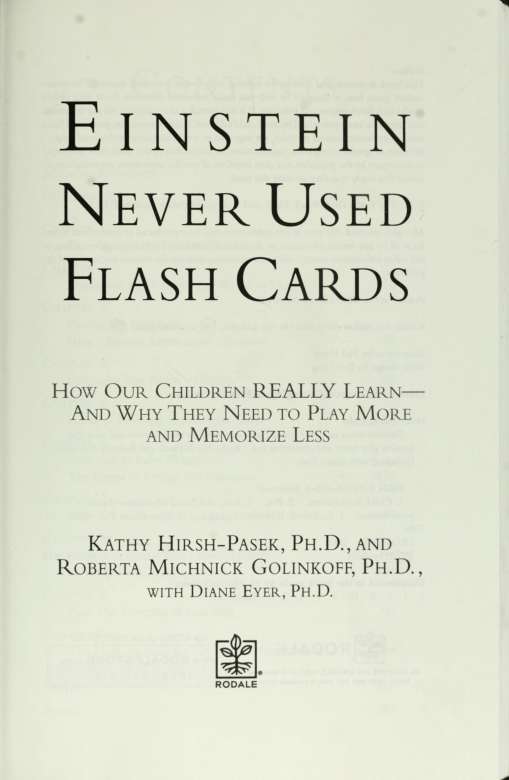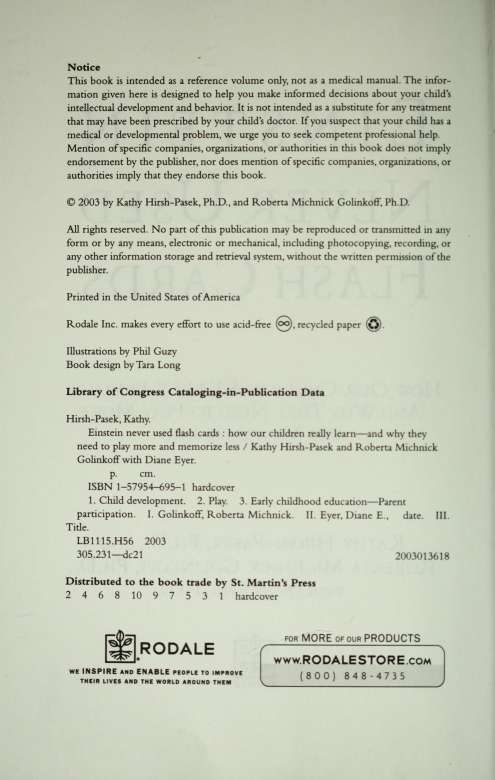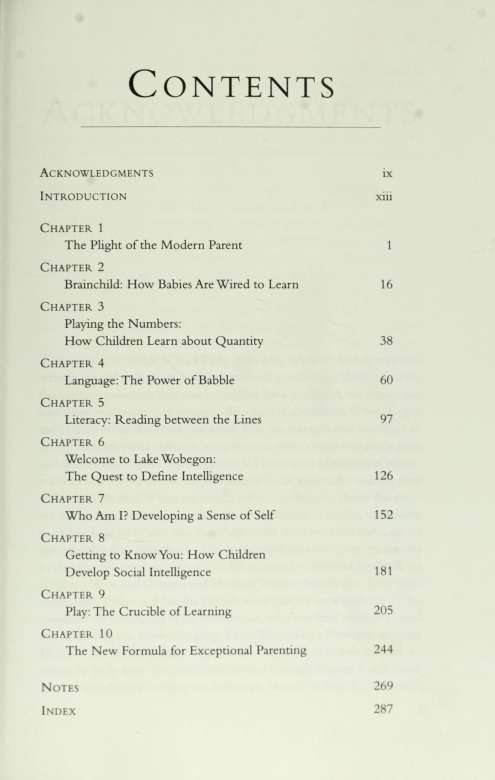This book made available by the Internet Archive.
Acknowledgments
THIS BOOK WAS WRITTEN BY US, it's true, but it was also written by our colleagues in developmental psychology. Were it not for the excellent research that our colleagues have produced, we would not have been in a position to promote the cause of childhood. When we got the idea to write this book, we knew that the research was out there to support the idea that children learn without extra classes and fancy toys, and that socioemotional development is a key aspect of successful adjustment in life. All we had to do was assemble the argument, and we even had help with that! When we would tell our colleagues about this project, it was invariably the case that they volunteered to read it, to endorse it, and to help us in any way that they could. And we took them up on the offer. Each chapter profited from the input we were given by experts in the area we were writing about. We received wonderful feedback on chapter 1 from Joel Gordon and Herman Werner. For chapter 2, we consulted John Bruer and Sandra Trehub, who quickly answered any of the questions we posed, and Nora Newcombe, who was kind enough to read the entire chapter. Herb Ginsburg, Karen Wynn, Nora Newcombe, James Hiebert, and Nancy Jordan helped with chapter 3, as did wonderful research by Kelly Mix. RichardVenezky read through chapter 5, and Frank Murray and Nancy Lavigne read through chapter 6. Marsh.i Weinr.mh.
Julie Hubbard, Carol Dweck, and Kim Cassidy were invaluable for their help in chapters 7 and 8. Ageliki Nicolopoulou alerted us to a wealth of information on play for chapter 9, a chapter that was also inspired by information from Dorothy Singer and Susan Bredekamp. One of the lessons we have learned in writing books for the popular press is that space limitations and "readability" prevent us from acknowledging all the wonderful research that contributed to this volume. We apologize in advance to our colleagues whose research we were unable to include. Finally, thanks to Jeff Pasek, Josh Pasek, Benj Pasek, and Michelle Reimer, who read through some of the material to make sure it was written in an accessible and engaging way.
Funding for some of our research reviewed in the book, and for its writing, came from grants from the National Science Foundation to both of us and from a National Institute of Child Health and Human Development grant to Kathy. We thank these agencies for understanding the importance that we place on disseminating the findings of our research and the research of others in a way that might have beneficial effects on the lives of children. Support of another sort came from our graduate students and laboratory coordinators, who were instrumental in helping us to assemble the relevant literature. They also provided us with much wonderful stimulation. It was a joy to work with Meredith Meyer, Dede Addy, Khara Pence, Mandy Maguire, Diane Delaney, Shannon Pruden, Sara Salkind, and Rachel Pulverman. Maryanne Bowers, Roberta's secretary at the University of Delaware, is excellent at responding with alacrity to our "we need this yesterday" requests. We thank our superlative Honors studentsboth at Temple University and at the University of Delaware for their insightful comments.
We also feel lucky to have found a writer who is also a developmental psychologist, Diane Eyer. Although she was literally in Kathy s backyard teaching at Temple University, she is a scholar and writer in her own right and it was a pleasure to work with her. The three of us made a good team, constandy in communication and constandy improving upon each other's writing.
Our agent, Barbara Lowenstein, has been a wonderful skeptic all along, and when we got the green light from Barbara, we knew it meant something! Fortunately for us, she placed us with a marvelous press: Rodale! Lou Cinquino, Amy Kovalski, and Sue Ducharme understood what we
Acknowledgments
were trying to do and gave us the freedom and feedback that facilitated its accomplishment.
And finally, we could not neglect to mention our wonderful families. Kathy's Jeff is our pro bono legal representative and official booster. Her children, Josh, Benj, and Mikey, furnished us with many anecdotes and much support, and her cousin Philissa Cramer is one of the best editors we have ever worked with. Roberta's children, Allison and Jordan, also contributed greatly to her understanding of children and childhood and continue to teach her the virtues of young adulthood.
We are especially fortunate to have mothers (and grandmothers) who serve as our role models. Kathy's grandmother, Helen, understood the value of play. She was the first to teach her how to ride a bike and about ice cream soup. Our mothers, Joan and Anne, are vibrant, involved, and engaged women who gave us as children just enough rope to venture out but not enough to hang ourselves! They served as secure bases for our attachment and continue to be our strongest advocates. So even if no one else likes this book (though we surely hope they do!), at least our mothers will. That's a great feeling!
= XI
thing from computer science to cooking classes to soccer leagues. His warning signs appeared even before parents could get quick child-rearing advice with just two keystrokes on the Internet. I (Kathy) was a junior professor at Haverford College, doing research on ''hurried children," and I was thrilled to host Professor Elkind during his speaking tour. I was also a parent of two young children, Josh, age 4, and Benj, age 2. While I knew that Professor Elkind was theoretically right about finding more downtime with our children and enjoying more playtime, I also felt the pain of hurried parents. Every time my friends would tell me about another art class, or another soccer league for toddlers, I worried that my children would be left behind in the rush toward success.
As a developmental psychologist, I knew that Professor Elkind was correct about the plight of the modern-day parent and child. Yet it took all the knowledge I had to resist the temptation to push my children too far and too fast. Using child development as my guide, I let them play. And 16 years later, I am happy to report that my two oldest sons (I now have three boys) both have gotten into the colleges of their choice and are happy, intelligent, and very creative people.
At the same time, I (Roberta) was raising my two children while a professor at the University of Delaware. Jordy (now Jordan) was 9 and Allison was 5. I remember when my son interviewed to attend a private school and I wondered whether I had failed him by not teaching him to read. But he was 4! The culture had worked its effect on me, despite the fact that I should have known better: I was a developmental psychologist. And yet I resisted because I knew that pushing children can backfire and create children who dread learning. It's not that we sat at home. We did our share of music classes and religious instruction, but we tried to draw the line in the sand at the extras that would have taken away the children's cherished playtime.

